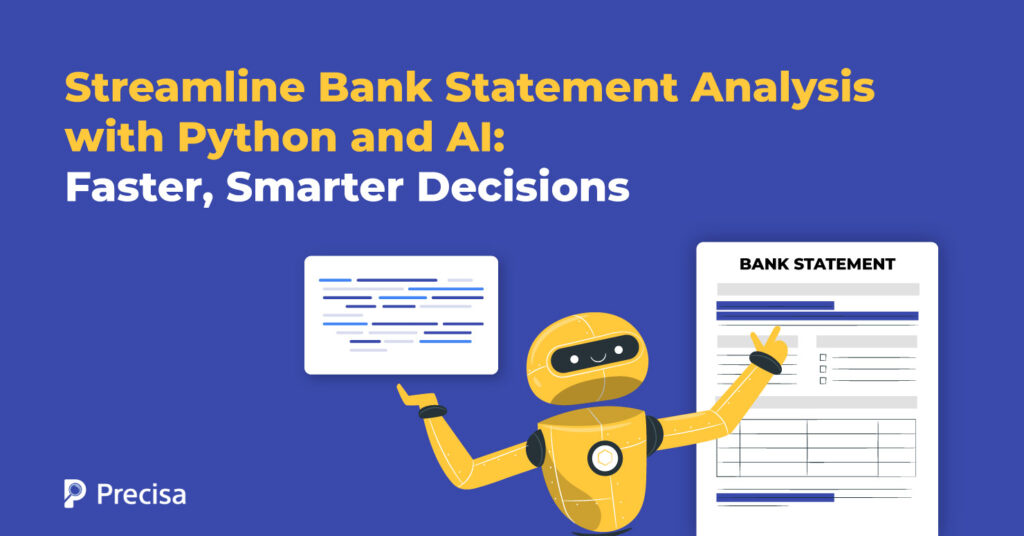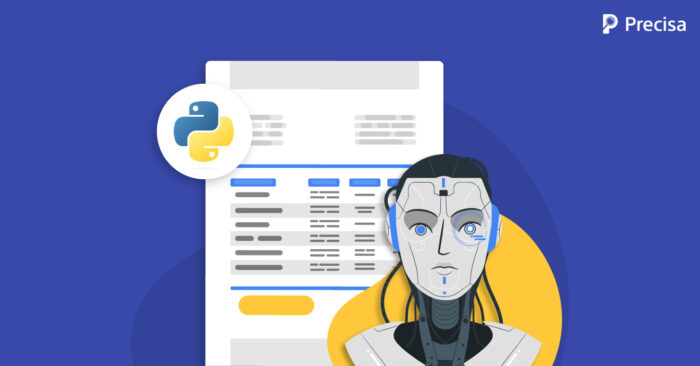Streamline Bank Statement Analysis with Python and AI: Faster, Smarter Decisions

Scaling a lending business presents a significant dilemma: higher loan volume increases potential profits but also the risk of default and fraud. Thorough risk assessment is essential, yet the sheer number of loans can make this process overwhelming. Lenders that embrace the benefits of technologies such as automation, Artificial Intelligence (AI), and Python can strengthen the underwriting process and power data-driven decisions. This blog post explores why forward-thinking lenders must leverage the benefits of bank statement analysis with Python and AI solutions.
What Are Automated Bank Statement Analysis Python And AI Solutions?
Assessing a borrower’s financial health and credibility is an important function in the underwriting process. However, a borrower’s credit history alone may not be adequate to help lenders make important decisions.
For this reason, lenders often review large volumes of bank statements to ascertain a borrower’s financial health.
However, this poses a significant challenge. Manually analysing bank statements can be labour-intensive and cumbersome, resulting in errors and omissions.
To accelerate risk assessment, reduce errors, and successfully scale their operations, lenders must adopt smart technologies. Automation powered by Python and AI can drastically improve accuracy and speed.
For instance, bank statement analysis with Python and AI automated software is completely transforming how banks, non-banking financial services, payment apps, and digital lending platforms evaluate borrowers and disburse loans.
Bank Statement Analysis With Python and AI: Deconstructing the Technologies
The use of these two technologies in bank statement analysis with Python and AI software is a potent combination:
Python
Python is a programming language and one of the most popular ones in use today. It is used in areas such as web development, data science, machine learning, and automation.
Three key advantages of Python include:
- Ease of use and learnability: Its clear syntax and readability make it ideal for beginners and experienced programmers alike.
- Versatility: With its vast ecosystem, Python excels in web development, data analysis, scientific computing, system administration, and more.
- Extensive libraries: It also boasts a rich collection of libraries and frameworks, providing pre-built solutions for tasks
Python is playing a growing role in risk assessment, an important function in the finance sector, particularly lending.
For instance, it can be used to build financial models that predict a business borrower’s future cash flows. Based on the results, lenders can decide whether to accept or reject a specific loan application.
AI
AI, a branch of computer science focused on building intelligent systems, is also changing the lending industry. It allows lenders to process vast amounts of data quickly and accurately, helping them make quicker decisions, better predict risks, and give customers a smoother experience. This also translates into more sustainable and profitable business models.
AI-powered bank analysis tools are helping businesses automate the process end-to-end. For example:
- It can recognise unusual transaction patterns and minute inconsistencies in documentation.
- AI also helps generate detailed reports on a borrower’s real-time financial status.
Benefits of Bank Statement Analysis with Python And AI Solutions

Here’s a brief snapshot of the differentiated value delivered by AI and Python-powered financial analysis tools:
Superior Risk Assessment Capabilities
The ability to predict risk accurately is a valuable asset to any financial business. Lenders need to analyse a host of documents, such as bank statements, invoices, and other relevant financial documents, to arrive at a more real-time conclusion about a borrower’s financials.
Specific patterns in borrowing habits are often challenging for the human eye to detect easily. A superior bank statement analysis with Python and AI software can perform the following:
- Transaction Categorisation: Automatically classifies all bank transactions into inflow and outflow categories, with further sub-categorisation for detailed analysis.
- Accurate, Real-Time Credit Scoring: Enables generation of precise credit scores based on up-to-date financial data.
- Clear Financial Picture: Provides lenders with a comprehensive view of the borrower’s financial behaviour, including:
- Income vs. expenses differentiation
- Salary payouts
- EMI payments
- Penalties
- Other incoming/outgoing transactions
Enhanced Fraud Detection Capabilities
With the proliferation of malpractices such as loan fraud and identity theft in the financial services sector, lenders must be able to detect potential fraud early on.
AI-powered Automated bank statement analysis software can recognise minute inconsistencies in bank documentation, which can be due to the use of fake documents. It can also detect inconsistencies related to the borrower’s identity in cases of impersonation.
Forecasting Future Trends
Businesses are always looking forward to being able to predict future trends and capitalise on new opportunities. Python can help develop specialised models that take historical data and process it to predict future trends and market opportunities.
As lenders collect more data from customers, this is a valuable asset that helps them expand their business models and better serve current and future customers.
Delivering Customised Solutions
There’s an emerging set of potential borrowers without a prior credit history. These borrowers mostly belong to the Micro, Small, and Medium Enterprise (MSME) sector and may also not hold much in terms of assets. Traditionally, lenders have rejected such borrowers due to the inability to predict their creditworthiness, thus losing out on opportunities.
However, the use of AI and Python in banking statement analysis software enables lenders to get an accurate picture of company revenues and cash flows. It also helps them build customised, cost-effective solutions that meet MSMEs’ diverse needs.
In turn, lenders can benefit by increasing the customer’s lifetime value when borrowers return to access more credit in the future.
Higher Return on Investment (ROI)
The adoption of superior bank statement analysis with Python and AI software is helping lenders achieve a higher ROI through quick, efficient, and accurate underwriting operations.
Lending businesses can run with lean teams, freeing up bandwidth for members to pursue strategic activities that drive business growth.
The Takeaway
The adoption of bank statement analysis Python and AI software is empowering lenders to make accurate underwriting decisions and run optimised, efficient operations.
By categorising transactions quickly, intuitively, and accurately and running predictive diagnostics, lenders can predict the potential of a borrower to pay back loans on time and in full and process loans quickly.
They can also reduce the risk of rising NPAs and loan fraud and build a sustainable, profitable business.
Presica’s comprehensive and seamless financial data analysis solution simplifies and speeds up the process through automation. The software provides actionable insights on a customisable dashboard, thus helping companies make informed business decisions.
Request a free demo today!



